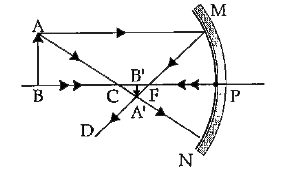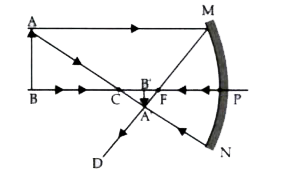The figure above shows a converging mirror its focal point F its center of curvature C and an object represented by the solid arrow.a On the figure above draw a ray diagram showing at least two incident rays and the image formed by them.b Is the image real or virtual?____ Real ____ VirtualJustify your answer.c The focal length of this mirror is 6.0 cm and the object is located 8.0 cm away from the mirror. Calculate the position of the image formed by the mirror. Do NOT simply measure your ray diagram.d Suppose that the converging mirror is replaced by a diverging mirror with the same radius of curvature that is the same distance from the object as shown below.For this mirror how does the size of the image compare with that of the object?____ Larger than the object ____ Smaller than the object ____ The same size as the object Justify your answer.
ab The image is on the same side as the object and is projectable thus real.c 1/f = 1/do + 1/di … 1/6 = 1/8 + 1/di … di = 24 cmd The converging mirror made a larger size object. The diverging mirror always makes the same type of image regardless of where the object is placed. It always makes smaller upright virtual images. This can be proved mathematically or with a ray diagram for this situation.
Related Solutions
Draw the ray diagram to show the formation of real and virtual image in concave mirror.
View SolutionFollowing figure illustrates the ray diagram for the formation of image by a concave mirror. The position of the object is beyond the centre of curvature of the concave mirror. On the basis of given diagram .

If the focal length of the concave mirror is 10 cm, the image formed will be at a distance ____View SolutionIt is desired to obtain an erect image of an object, using concave mirror of focal length of 12 cm.
(i) What should be the range of the distance of an object palced in front of the mirror?
(ii) will the image be smaller or larger than the object. Draw ray diagram to show the formation of image in this case.
(iii) Where will the image of this object be , if it is placed 24 cm in front of the mirror? Draw ray diagram for this situation also to justify your answer.
Show the position of pole, principle focus and the centre of curvature in the above ray diagrams.View SolutionIt is desired to obtain an erect image of an object, using concave mirror of focal length of 12 cm.
(i) What should be the range of distance of an object placed in front of mirror ?
(ii) Will the image be smaller or large than the object ? Draw a ray diagram to show the formation of image in this case.
(iii) Where will the image of this object be, if it is placed 24 cm in front of the mirror ? Draw a ray diagram for this situation also to justify your answer.
Show the positions of the pole, the principal focus and the centre of curvature in the above ray diagrams.View SolutionIt is desired to obtain an erect image of an object, using concave mirror of focal length of 12 cm.
(i) What should be the range of distance of an object placed in front of the mirror?
(ii) Will the image be smaller or larger than the object. Draw ray diagram to show the formation of image in this case.
(iii) Where will the image of this object be, if it is placed 24 cm in front of the mirror? Draw ray diagram for this situation also to justify your answer. Show the positions of pole, principal focus and the centre of curvature in the above ray diagrams.View SolutionIt is desired to obtain an erect image of an object, using concave mirror of focal length of 12 cm. (i) What should be the range of distance of an object placed in front of mirror ? (ii) Will the image be smaller or large than the object ? Draw a ray diagram to show the formation of image in this case. (iii) Where will the image of this object be, if it is placed 24 cm in front of the mirror ? Draw a ray diagram for this situation also to justify your answer. Show the positions of the pole, the principal focus and the centre of curvature in the above ray diagrams.
View SolutionWhat is the minimum number of rays required for locating the image formed by a concave mirror for an object ? Draw a ray diagram to show the formation of a virtual image by a concave mirror.
View SolutionWhat is the minimum number of rays required for locating the image formed by a concave mirror for an object. Draw a ray diagram to show the formation of a virtual image by a concave mirror.
View SolutionDraw a ray diagram to show image formation when the concave mirror produces a real inverted and magnified image of the object
View SolutionDraw a ray diagram to show image formation when the concave mirror produces a real, inverted and magnified image of the object.
View Solution
Above figure illustrates the ray diagram for the formation of image by a concave mirror. The position of the object is beyond the center of curvature of the concave mirror. On the basis of given diagram answer the following questions.
If the focal length of the concave mirror is 10 cm, the image formed will be at a distance ________View SolutionFig. shows a concave mirror with its pole at P, focus F and centre of curvature C. Draw ray diagram to show the formation of image of an object OA.
View SolutionDraw a ray diagram showing the formation of image of a point object by a plane mirror.
View SolutionAn object is placed in front of a concave mirror at a distance of 7.5 cm from it. If the real image is formed at a distance of 30 cm from the mirror, find the focal length of the mirror. What would be the focal length if the image is virtual.
View SolutionAn object is placed in front of a concave mirror at a distance of 7.5 cm from it. If the real image is formed at a distance of 30 cm from the mirror, find the focal length of the mirror. What would be the focal length if the image is virtual.
View SolutionAn object is placed in front of a concave mirror of focal length 20 cm and an image of magnification -2 is formed. Find the position of the object and the image. Draw a ray diagram.
View SolutionDraw the ray diagram to show the formation of real and virtual image in concave mirror.
View SolutionDraw a ray diagram to show formation of virtual image by a concave mirror
View SolutionWhen the object is situated at the center of curvature of a concave mirror, then show the process of image formation by drawing a ray diagram.
View SolutionMake lablled ray diagrams to ollustrate the formation of : (a) a real image by a converging mirror. (b) a virtual image by a converging mirror. Mark clearly the pole, focus, centre of curvature and object in each case.
View Solution
